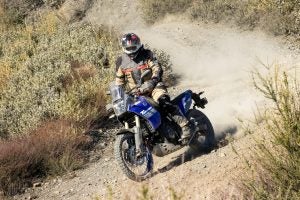Note; We’ve already run David Hilgendorf’s First Ride review of the Kawasaki KLX300 dual sport (see it here), but Zac’s recently got his hands on a KLX and wanted to share his own experiences—Ed.
I like small bikes, especially small dual sports. When you want to head down tight trails, a 250 makes sense, even a 200. However, when you want to hit the highway, a 350 has just a bit more jam, and you generally don’t add much weight. Win-win.
So, when I saw Kawasaki was kinda-sorta morphing the KLX250 into a KLX300, I was intrigued. There hasn’t been a Japanese 350 dual sport since Yamaha canceled the XT350 (around 2001, depending which market you’re in). Would the new KLX prove to be that just-right blend, adding horsepower to the old 250 class without any unnecessary bulk? Kawasaki set me out a bike, and I resolved to find out.
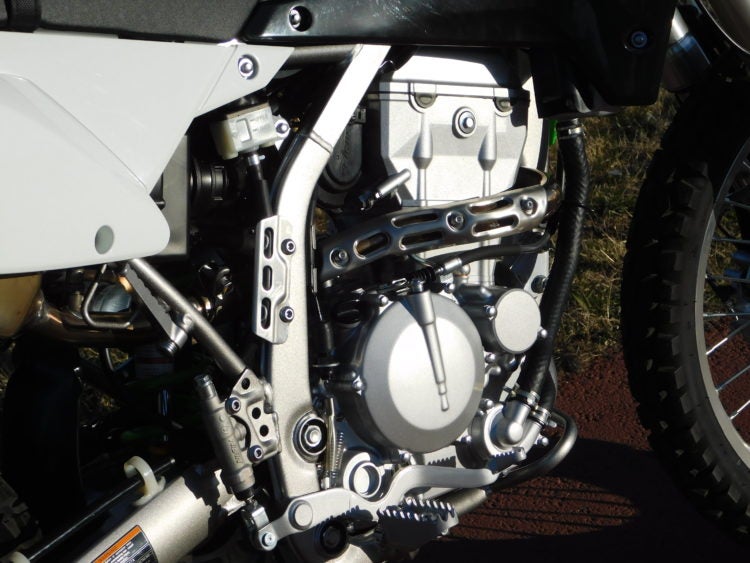
The engine is the biggest question mark. Turns out the updated 292 cc single does indeed have more grunt, but it is not well-suited for the highway either. Photo: Zac Kurylyk
First impressions
“Try to take it easy for the first few miles,” Kawasaki asked me—a fair request, since I picked up the machine with no mileage on the clocks, meaning it was at the start of its break-in period. A nice, easy tootle through the city of Fredericton, then down back roads to home base via New Brunswick’s Route 101.
This is pretty much the quintessential Atlantic Canadian back road: Curves, bumps, and rolling terrain. Sticking to the posted 80 km/h speed limit, the KLX was right at home. Kawasaki didn’t actually make this engine into a 300; it’s actually 292 cc, but that was enough to make a noticeable difference on the hills.
Kawasaki doesn’t actually publish horsepower numbers, but most people figure the KLX300 makes about 29 horsepower at the crank. Whatever it makes, it is a noticeable improvement over most of the old Japanese 250 dual sports.
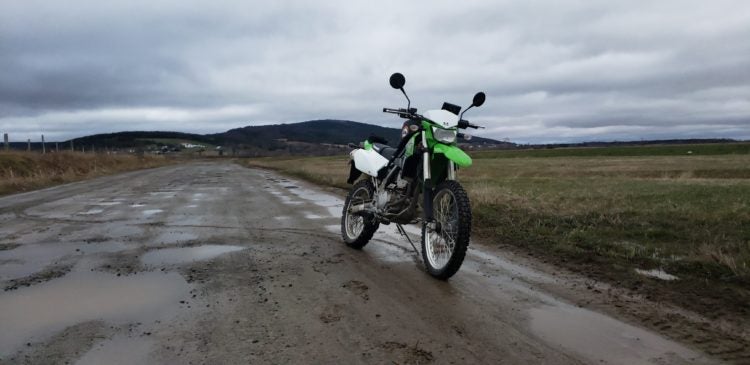
Gravel roads through the back country of New Brunswick. The KLX is well-suited for this sort of exploration. Photo: Zac Kurylyk
Kawasaki also says the KLX300 uses a new chassis, based off the KLX300R dirt bike. Um, maybe. It looks a lot like the old steel frame/aluminum swingarm arrangement the KLX250 used, although a few of the dimensions are different (less ground clearance), showing that Kawasaki did indeed tinker with the formula somewhat.
The result is what I’d consider pretty decent street handling manners, considering it’s a budget-oriented machine. Should you be unhappy with the stock suspension settings, get busy tweaking things. There’s adjustable compression damping up front, and compression and rebound damping adjustability in rear, as well as preload adjustability.
The suspension is arguably the KLX’s strongest point as a result, and it was more evident when I did some mild trail riding.
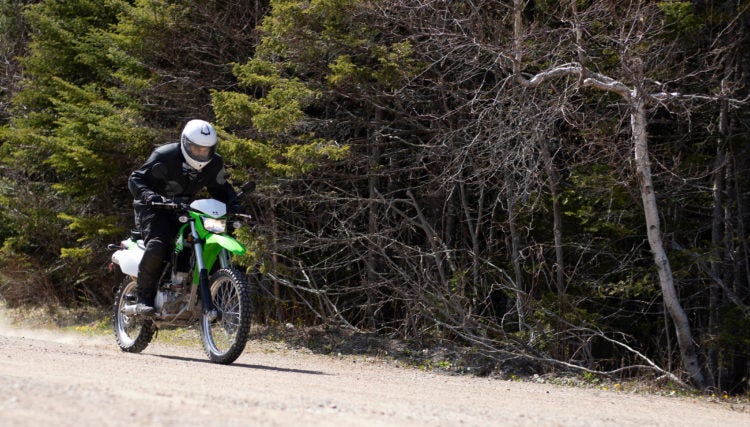
I would say the KLX is a better trail bike than it is a travel bike. It’s great on the street as long as you have sensible speeds in mind, though, and works very well in the city. Photo: Laura Deschenes
Headed to the woods
In the two weeks I had the bike, I didn’t have much opportunity to ride offroad. That’s disappointing, because when I took the KLX down my favourite pipeline trails, ATV tracks and woods roads, I felt this was where the bike was really at home.
Kawasaki always plays up the trail bike heritage in its KLX marketeering, and I think the sneers from the Euro bike crowd are missing the point. No, this isn’t a slim-Jim enduro made for racing; it’s a solidly built dual sport that’s made to handle rough usage without constant maintenance, at a price that average riders can afford. It’s not made for winning woods races, it’s made for tootling up to the cabin for the weekend, and exploring the area’s gravel roads when you get there. You can push it down fairly tight stuff if you want, you’ll just have to take a slower pace and work harder.
Again, the suspension really works well here, if you’re riding the speeds the bike is designed for, with none of the cheap, bouncy rear-end pogoing that older 250 dual sports suffered from. In stock out-of-the-box form, the KLX suspension is better than any other entry-level duallie I’ve owned or ridden over the years, including the KLR650 and DR650. That’s not really saying much – you could even say it’s damning with faint praise – but it’s worth pointing out. If you’re on the market for a basic dual sport to trail ride, and you don’t want to spend a lot of cash, this is a good place to start looking.
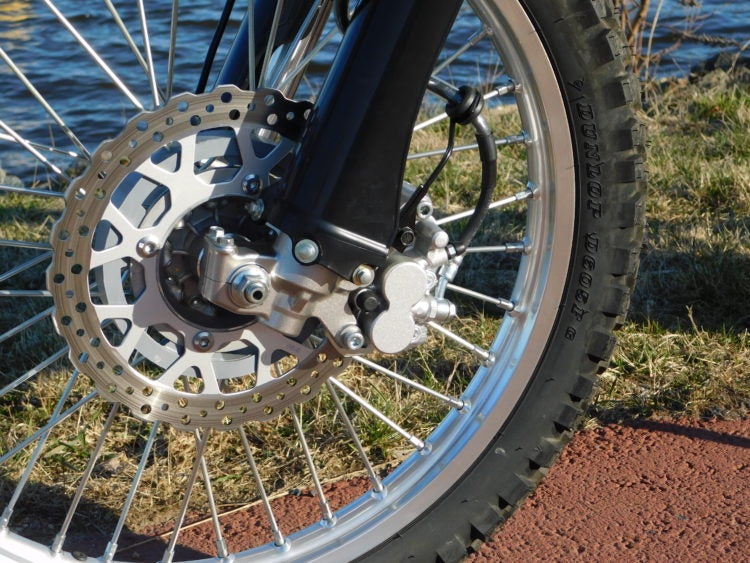
Better braking than the old KLR models, with two-piston caliper. Photo: Zac Kurylyk
The extra engine displacement is welcome here, too. You won’t be effortlessly lofting the front wheel over logs, but it’s definitely more torquey than the stereotypical gutless 250. More power would be welcome, but it’s an improvement.
There’s one problem, though. From the factory, Kawasaki doesn’t put handguards or a skid plate on the KLX300. I’m sure that reduces MSRP, and many riders will never care. However, I think these are essential upgrades if you’re planning to ride the rough stuff with the KLX. You might not want to spend the money protecting yourself or your bike, but it’s often cheaper and easier in the long run.
Back road rambling
I wrapped up the KLX test with three long days of rides through rural New Brunswick along a mixture of paved secondary highways, deserted farm roads, and some gravel sections. It wasn’t a proper camping trip, as I stayed overnight with family members, but it was as close to a motorcycle tour as I could get under current local COVID-19 restrictions.
Touring on the KLX is fun, as long as you take a break now and then. If you’re running around 100 km/h (approximately 60 mph) or more, the engine buzz gets to you after a while. This is no surprise to anyone who’s been around the dual sport scene for a while, but past 7,000 rpm, the 300 engine still has plenty of buzz. It makes more horsepower, but it’s still only a 292 cc single. The engine still had to work pretty hard on steeper grades through the smallish mountains of Fundy National Park, and on the highway, there’s no real difficulty keeping up a safe pace in the slow lane. But, don’t expect to cruise in the fast lane.
The best way to enjoy longer days on this duallie is to stick to smaller roads, then, and just accept a slower pace. Accept that you won’t make the big miles you’d do on an FJR1300; focus on exploring off the beaten path. Make sure you don’t go tooooo far, though, unless you pack a Rotopax gas can. The two-gallon fuel tank doesn’t give you much range, and for me, the fuel light usually came on somewhere around the 75-mile mark.

No skid plate, and also no handguards either. Kawasaki passes those costs on to the bike’s buyer. Photo: Zac Kurylyk
Closing thoughts
There isn’t much difference between the KLX300 price tag and a KLR650 or even a DR650, especially if you’re spreading payments over a few years. The KLX still doesn’t have the power to be a true all-rounder, like those machines. However, it’s probably a superior trail bike, at least for many riders’ usage. Adventure bikers looking for a tough, no-nonsense mount that can handle hard offroad usage would be well-served to consider the KLX300, as it’s certainly an upgrade over the old 250 class. No, it’s not a thoroughbred enduro, but it does dual duty well, with more dirt capability than the current Japanese competition in this class. I’d look at it for a trail bike, but maybe not a travel bike, especially with that —Honda’s 300 series, or even a leftover Yamaha WR250R, will probably provide better satisfaction in that role. No worries, though—with the KLX, you can just focus on adventures that are closer to home base.
US pricing starts at $5,599; Canadian pricing starts at $6,499. See full specs, deets, and moret photography of the bikes at Kawasaki’s website (US or Canada).






